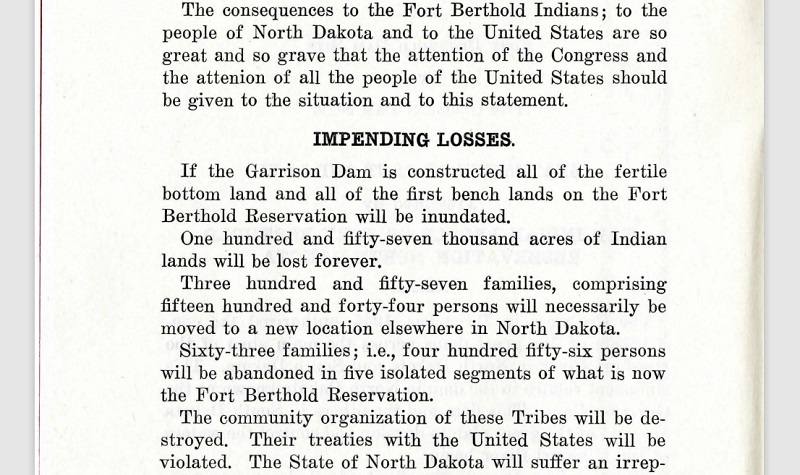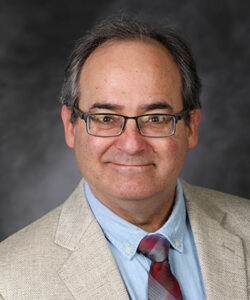UND partners with tribal college on NEH digitization grant
Together with Nueta Hidatsa Sahnish College, UND will digitize historic documents, expand language resources and create K-12 curriculum

North Dakota’s delegates to the U.S. Congress almost always sit on the Senate or House committees on Indian affairs. Their papers – plus those of North Dakota’s governors, who also have extensive interactions with the Indigenous Nations located in what is now North Dakota – often wind up in the Chester Fritz Library at UND.
That means the Department of Special Collections at the library contains a veritable treasure trove of documents related to the history of Indigenous peoples of the region.
And now, thanks to funding from a major grant from the National Endowment for the Humanities, and in partnership with Nueta Hidatsa Sahnish College in New Town, N.D., UND will continue to create digital copies of and link to key materials related to the histories of the Indigenous peoples of the region.
The project, titled “Strengthening & Preserving the Mandan, Hidatsa and Arikara Nation’s Humanities Infrastructure,” recently was awarded nearly $500,000 from the NEH. The funding will be split 40/60, with NHS College getting the 60 percent share.

Partnership plan
UND will use its portion of the grant to:
• Expand its digital collection of the William Langer papers, emphasizing documents related to the Garrison Dam construction and other issues of importance to the Mandan, Hidatsa and Arikara Nation.
The 900 boxes of papers from Langer – the former state’s attorney, governor and U.S. senator – includes extensive information about the dam, including its repercussions and the MHA Nation’s fight against the dam’s construction.
• Digitize selections from the papers of Usher L. Burdick, former state representative, lieutenant governor and longtime North Dakota representative in the U.S. House. Three full boxes of the 38-box Burdick papers are dedicated to “Indian Affairs,” including the construction of the Garrison Dam.
• Expand the U.S. government documents related to the MHA Nation. As a federal depository, the Chester Fritz Library has many government documents that relate to Indian boarding schools in North Dakota, the Superintendency of Indian Affairs from Dakota Territory in the 1800s, and similar topics. Digitizing these materials and making them available on the Internet will create a valuable resource.
In turn, Nueta Hidatsa Sahnish College in New Town will use its grant funding to:
• Continue digitizing the Special Collections and MHA Language holdings in the College’s Singing Spring Library and Cultural Center. The library’s website also will be updated to accommodate electronic searches and cataloging.
• Gather additional oral histories, resources and other sources of knowledge, especially regarding Indigenous languages.
Currently, there are no fluent Mandan speakers, and before the pandemic, there were only about 30 to 50 fluent Arikara speakers and about 100 fluent Hidatsa speakers, the College reports. This gives special urgency to the task of preserving and perpetuating the MHA Nation’s languages and traditions.
• Expand the College’s seed library and make traditional knowledges more accessible.
The MHA Nation’s extensive traditional gardening practices were massively disrupted by the Garrison Dam’s construction, which flooded the reservation’s fertile bottomlands. Luckily, several families continued to garden and carry on the traditional seeds and practices; and today, the College not only offers classes in Traditional Gardening and Foods, but also saves seeds and sponsors plant walks, garden days and other activities to bring programming to tribal members and the region.
• In partnership with MHA Nation and assisted by UND, create complementary curriculum for K-12 teachers who lead classes in North Dakota Studies. All North Dakota fourth-and eighth-graders must take North Dakota Studies, and the classes must include the history of the region’s Indigenous people as well as the state, the North Dakota Century Code directs.

Highly significant
“I don’t think that it is possible for me to articulate the significance of the work that will be done as a result of this funding,” said Crystal Alberts, associate professor of English and digital humanities specialist at UND.
“My UND colleagues and I are honored to be able to partner with our colleagues at Nueta Hidatsa Sahnish College to learn from and support each other as we each endeavor to preserve and digitize the histories and knowledges of MHA Nation at our respective institutions.”
Brad Rundquist, dean of the College of Arts & Sciences at UND, agreed. “The College of Arts & Sciences is honored to do our part in helping to preserve and enhance access to the documents that tell the stories of the MHA Nation’s history, governance and tribal sovereignty,” he said.
“We value both the important work that will be done as well as the benefits of what will be a productive and enriching collaboration.”
And as UND President Andy Armacost noted, “This grant award is another advancement for UND’s ongoing efforts not only to strengthen its American Indian studies program, but also digitally preserve and make available critical historical and cultural information about the Mandan, Hidatsa and Arikara Nation.
“These three tribes were among the first occupants of what became known as the Dakota Territory – long before settlers arrived,” Armacost continued. “It is fitting that we partner with Nueta Hidatsa Sahnish College in this important endeavor to preserve these valuable resources for current and future generations to study.”
NHS College President Twyla Baker both welcomed the collaboration with UND, and looked forward with excitement to the knowledge that the NEH grant will help make available.
“This partnership will serve to help us bridge gaps for our Tribe’s needs in preserving and revitalizing our cultural and traditional lifeways by helping us train the next generations of caretakers,” Baker said.
“We are excited to enter into this partnership with our colleagues at UND for such crucial work. I look forward to working with them!”



